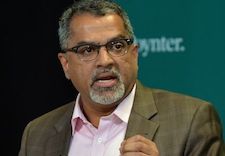Younger staff in The Atlantic newsroom have a knack for sourcing their stories through social media, and getting them read that way, too, J.J. Gould, executive editor at TheAtlantic.com, said Monday morning at the Poynter Institute.
Gould was part of a panel, moderated by Vivian Schiller, head of news at Twitter, at the Future of News Audiences conference (live blog here).
Those younger staff, Gould said, have a sense for “how to play this emerging understanding of what readers are looking for with mission of The Atlantic.”
But when you ask most newsrooms what they’re doing with information about their audiences, “the majority of them will tell you very little,” said Raju Narisetti, senior vice president of strategy at News Corp.
“There is still a tremendous disdain for taking our understanding of digital audiences and doing something about it.”
His fear, he said, is that unless newsrooms understand data about their audiences and what they’re reading and then use that information, they’ll be left behind, “especially by some of the newer newsrooms that are kind of legacy-free, if you will, like Upworthy or BuzzFeed that can embrace the data and do something about it.”
So is it a gut instinct, Schiller asked the panel, that guides the younger and legacy-free journalists in deciding what data they look at and what they do with it?
Gould compared it more to athleticism, that reporters are learning on the field, and that what they’re learning is always shifting.
When he first started at The Atlantic four years ago, Gould said, there was a reluctance among senior editors that journalists have access to data.
“It’s an understandable reflex, to say don’t look at the data,” Gould said. “Like don’t read reviews.”
But, he said, no one worries about that anymore.
Reporters, he said, are still following their beats and interests and working on what’s relevant to their readers. “But the knack is developed by iterative reading of data,” he said.
Marcy McGinnis, senior vice president of newsgathering at Al Jazeera America, said there’s not a strict rule on sharing audience data with reporters, and editors often allude to it without specifics so that the newsroom has an impression of what the data’s saying.
“We don’t want the journalism to get interfered with,” she said. “We want the process to improve, we want them to understand how to get more eyeballs, but at the same time, we don’t want them to get away from traditional journalism.”
That could be viewed as paternalistic, Schiller said, to deny people information, “whose job it is to seek information.”
Next she turned to Andrew Forrest, director of audience development at Upworthy, and asked how Upworthy uses audience data.
When Upworthy started two years ago, Forrest said, “we were never counting on direct traffic to our website. We have been social first forever.”
Upworthy doesn’t write headlines for SEO or direct traffic but for Facebook. It sees what’s getting traction and talk about how to distribute it, paying attention to audience signals to determine what gets pushed out in the moment. And those choices are made by an editorial team.
“We get parodied a lot for our headlines,” Forrest said, “but the editorial team we have is fantastic.”
There are a lot of reasons stories may do well, and those reasons often have nothing to do with the journalism, Narisetti said. But looking at audience data can, over time, help newsrooms understand how to prioritize their resources.
On most mainstream media homepages this week, he said, there is probably a story about civil unrest in Egypt.
“Trust me, that story is probably doing very, very poorly.”
That doesn’t mean it should get dropped because of that, however, but using that data, newsrooms should ask, what can we do to make this more engaging, Narisetti said.
At The Atlantic, Gould said, there are no traffic targets, but data can help coach reporters and newsrooms can discover areas of reader interest that may surprise them. For The Atlantic, that was a strong response to a piece on comparative analysis of education systems.
“You can actually learn about areas of reader interest that are at the heart of your mission,” he said.
Using audience data is suggestive, he said, and Narisetti agreed.
“My view of data has always been it complements news judgement, it doesn’t replace it.”
Related stories: Future of News Audiences live blog: what we are hearing
Related training: Using Analytics to Drive Website Success | Mobile Metrics: Truth and Myths








Comments